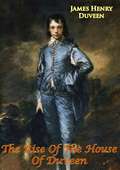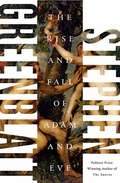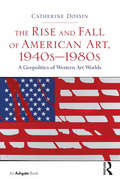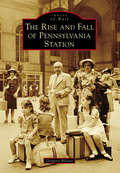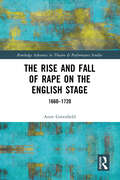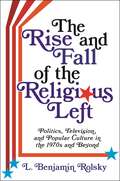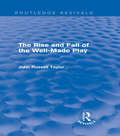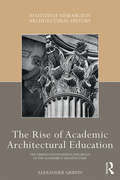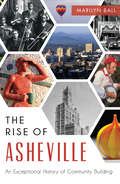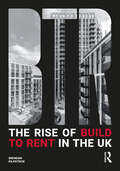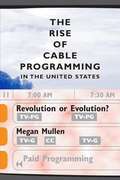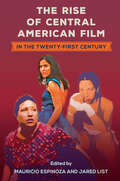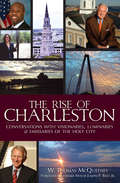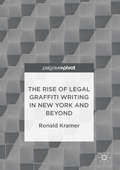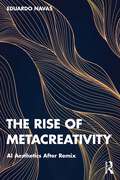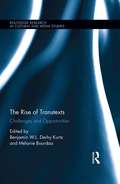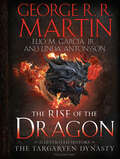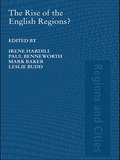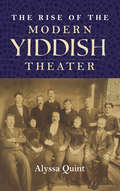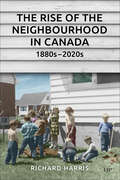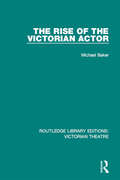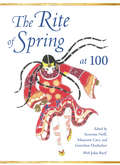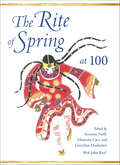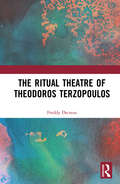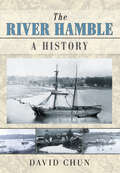- Table View
- List View
The Rise Of The House Of Duveen
by James Henry DuveenThis book provides an exciting portrayal of the history of the Duveen family in the art business up to 1939."THOUGH MANY REASONS have contributed to impel me to write this hook, the chief one is the memory of my uncle Joel Joseph Duveen. On the death of my father at the untimely age of twenty-nine, when I was four years old, my uncle was appointed my guardian by the Dutch court. He took a constant interest in me as I grew up; and, seeing how much I admired his energy and brilliance, he loved to tell me his interesting experiences. I was an eager listener and made notes of all he told me. He frequently invited me to accompany him on long journeys, and I spent many holidays with him on the Continent; the most pleasurable and exciting parts of these travels with him were the stories of his early life and the reminiscences of his business career."A friend [...] sent me in 1954 a fascinating book, Duveen, by S. N. Behrman, a gifted American author, which I read with the greatest interest. In it he has produced a brilliant picture of Lord Duveen's character and methods, and he is to be congratulated on his successful portrait. But this exciting book is chiefly concerned with the period of Lord Duveen; and I am grateful to its author for inspiring me to take up my pen again and place on record the greatness of the older generation who, by more brilliant but less grandiose methods, created the firm Lord Duveen raised to a height that may never again be equalled."I therefore began [...] to set down my memories of a line of great and intrepid connoisseurs in art. In our careers the art treasures in which we dealt and the great figures who formed our clientele are more interesting than we are ourselves. For this reason I have tried to picture the characters of my family by their adventurous dealings rather than by long biographical sketches; the incidents related are authentic in all details except names, some of which have been disguised for obvious reasons."
The Rise and Fall of Adam and Eve
by Stephen GreenblattStephen Greenblatt, the National Book Award- and Pulitzer Prize-winning author, investigates the life of one of humankind's greatest stories. The Rise and Fall of Adam and Eve explores the enduring story of humanity's first parents, and through them, of Western civilization. Greenblatt explores the tremendous theological, artistic, and cultural creativity over the centuries that made Adam and Eve so profoundly resonant, and continues to make them, finally, so very "real" to millions of people even in the present. Be sure to read the photo captions which are placed after the Index as these are especially interesting in this book. Greenblatt gives equally full coverage to both believers and skeptics.
The Rise and Fall of American Art, 1940s–1980s: A Geopolitics of Western Art Worlds
by Catherine DossinIn The Rise and Fall of American Art, 1940s-1980s, Catherine Dossin challenges the now-mythic perception of New York as the undisputed center of the art world between the end of World War II and the fall of the Berlin Wall, a position of power that brought the city prestige, money, and historical recognition. Dossin reconstructs the concrete factors that led to the shift of international attention from Paris to New York in the 1950s, and documents how ’peripheries’ such as Italy, Belgium, and West Germany exerted a decisive influence on this displacement of power. As the US economy sank into recession in the 1970s, however, American artists and dealers became increasingly dependent on the support of Western Europeans, and cities like Cologne and Turin emerged as major commercial and artistic hubs - a development that enabled European artists to return to the forefront of the international art scene in the 1980s. Dossin analyses in detail these changing distributions of geopolitical and symbolic power in the Western art worlds - a story that spans two continents, forty years, and hundreds of actors. Her transnational and interdisciplinary study provides an original and welcome supplement to more traditional formal and national readings of the period.
The Rise and Fall of Pennsylvania Station (Images of Rail)
by Gregory BilottoThe construction of Pennsylvania Station (1904-1910) was a monumental undertaking equally for the voluminous earth displaced, incredible innovation, and brilliant French-influenced classical architecture, but it also was a quintessential archetype of the Gilded Age. The station reshaped the economic and social fabric of New York by dislodging scores of families and local businesses. It had been built for prestige and grandeur rather than sustainability and prolonged the rivalry with the New York Central and Hudson River Railroads, leading to the creation of Grand Central Terminal. Although the station was successful for increasing passenger journeys, the rise of independent travel after World War II and mounting financial losses culminated with its unfortunate demise and eventual destruction. Nevertheless, through the misfortune of demolition emerged the first historic preservation laws, which have saved countless historic buildings, including its Park Avenue rival.
The Rise and Fall of Rape on the English Stage: 1660–1720 (ISSN)
by Anne GreenfieldThis book examines one of the most pervasive and successful dramatic tropes of the Restoration and early eighteenth century: sexual violence.During this sixty-year span, there were over fifty tragic and tragi-comedic productions that showcased rape and/or attempted rape—a remarkable number that was unprecedented in English dramatic history. Rape was not merely depicted more frequently during the Restoration, but it was also placed at the center of more plots, given more pathetic emphasis, and even staged more centrally. Restoration dramatists were the first to revolve routinely entire plots around the rapes of their innocent heroines, to give powerful voices to these heroines post-rape, and to imbue their sexually violent scenes with new and attention-getting staging techniques, such as discovery scenes. As this book argues, sexual violence emerged at this time as a highly flexible dramatic trope that could be used to illustrate terrifying political scenarios, elicit extreme pathos in audiences, and demonstrate the bearing that lost chastity had on social stability. It is precisely the rich, multi-faceted appeal of these productions—politically, sexually, visually, and culturally—that explains the popularity and significance of this dramatic trope on the English stage.This book will be of interest to students and scholars in Restoration, eighteenth-century studies, and theatre and performance studies.
The Rise and Fall of the Religious Left: Politics, Television, and Popular Culture in the 1970s and Beyond (Columbia Series on Religion and Politics)
by L. Benjamin RolskyFor decades now, Americans have believed that their country is deeply divided by “culture wars” waged between religious conservatives and secular liberals. In most instances, Protestant conservatives have been cast as the instigators of such warfare, while religious liberals have been largely ignored. In this book, L. Benjamin Rolsky examines the ways in which American liberalism has helped shape cultural conflict since the 1970s through the story of how television writer and producer Norman Lear galvanized the religious left into action.The creator of comedies such as All in the Family and Maude, Lear was spurred to found the liberal advocacy group People for the American Way in response to the rise of the religious right. Rolsky offers engaged readings of Lear’s iconic sitcoms and published writings, considering them as an expression of what he calls the spiritual politics of the religious left. He shows how prime-time television became a focus of political dispute and demonstrates how Lear’s emergence as an interfaith activist catalyzed ecumenical Protestants, Catholics, and Jews who were determined to push back against conservatism’s ascent. Rolsky concludes that Lear’s political involvement exemplified religious liberals’ commitment to engaging politics on explicitly moral grounds in defense of what they saw as the public interest. An interdisciplinary analysis of the definitive cultural clashes of our fractious times, The Rise and Fall of the Religious Left foregrounds the foundational roles played by popular culture, television, and media in America’s religious history.
The Rise and Fall of the Well-Made Play (Routledge Revivals)
by John Russell TaylorFirst published in 1967, this title considers the idea of the ‘well-made play’ in the context of how and why it has been devalued and how far, in allowing it to be devalued, we have lost sight of certain important elements of the theatre. The focus of the book is largely on the development of British theatre and those who have been instrumental to it. This is an indispensable introduction for any student with an interest in the history and development of the British theatre.
The Rise of Academic Architectural Education: The origins and enduring influence of the Académie d’Architecture (Routledge Research in Architectural History)
by Alexander GriffinAcademic architectural education started with the inauguration of the Académie d'Architecture on 3 December 1671 in France. It was the first institution to be devoted solely to the study of architecture, and its school was the first dedicated to the explicit training of architectural students. The Académie was abolished in 1793, during the revolutionary turmoil that besieged France at the end of the eighteenth century, although the architectural educational tradition that arose from it was resurrected with the formation of the École des Beaux-Arts and prevails in the ideologies and activities of schools of architecture throughout the world today. This book traces the previously neglected history of the Académie’s development and its enduring influence on subsequent architectural schools throughout the following centuries to the present day. Providing a valuable context for current discussions in architectural education, The Rise of Academic Architectural Education is a useful resource for students and researchers interested in the history and theory of art and architecture.
The Rise of Asheville: An Exceptional History Of Community Building
by Marilyn BallAs newcomers flocked to Asheville over the last fifty years, they joined with locals to breathe new energy into the city. Sometimes called the Asheville One Thousand, these folks didn't necessarily intend to be entrepreneurs, community organizers and business leaders, but when they saw a challenge, they rose to it. Stone Soup became a gathering place and laid the foundation for Asheville's natural food culture. MANNA Food Bank emerged to help solve hunger. And the River Arts District turned into a vibrant cultural center for upcoming artists. Join author Marilyn Ball as she traces the bonds of community that gave rise to Asheville today.
The Rise of Build to Rent in the UK
by Brendan KilpatrickBuild to Rent (BTR) is a form of residential tenure which first emerged in the United States, where it is known as Multifamily Housing. While it has been a mature asset in the United States for over a decade, it is relatively new to the UK and Ireland. The Rise of Build to Rent in the UK examines how this type of housing can play a key role in streamlining design and construction activity in a forward-facing manner which embraces climate change resilience and digital methods for delivery and management within the circular economy. The book examines the background of traditional UK home-owning and renting from which this new sector emerged, and charts BTR’s momentum swing in 2016 and on-going expansion to the present day, describing the potential of the BTR model in terms of both economic and climate sustainability and evaluating the key ingredients to success. The Rise of Build to Rent in the UK concludes with five highly illustrated UK case studies which evaluate the practical deliverability of real world BTR projects. This book will be of interest to BTR operators and investors, constructors, housing associations, municipal authorities and students of architecture and urban planning.
The Rise of Cable Programming in the United States: Revolution or Evolution?
by Megan MullenIn 1971, the Sloan Commission on Cable Communications likened the ongoing developments in cable television to the first uses of movable type and the invention of the telephone. <P><P>Cable's proponents in the late 1960s and early 1970s hoped it would eventually remedy all the perceived ills of broadcast television, including lowest-common-denominator programming, inability to serve the needs of local audiences, and failure to recognize the needs of cultural minorities. Yet a quarter century after the "blue sky" era, cable television programming closely resembled, and indeed depended upon, broadcast television programming. Whatever happened to the Sloan Commission's "revolution now in sight"?
The Rise of Central American Film in the Twenty-First Century (Reframing Media, Technology, and Culture in Latin/o America)
by Mauricio Espinoza Jared ListHow an overlooked film industry became a cinematic force The first book in English dedicated to the study of Central American film, this volume explores the main trends, genres, and themes that define this emerging industry. The seven nations of the region have seen an unprecedented growth in film production during the twenty-first century with the creation of over 200 feature-length films compared with just one in the 1990s. This volume provides a needed overview of one of the least explored cinemas in the world. In these essays, various scholars of film and cultural studies from around the world provide insights into the continuities and discontinuities between twentieth- and twenty-first-century cinematic production on the Isthmus. They discuss how political, social, and environmental factors, along with new production modes and aesthetics, have led to a corpus of films that delve into issues of the past and present such as postwar memory, failed revolutions, trauma, migration, popular culture, minority populations, and gender disparities. From Salvadoran documentaries to Costa Rican comedies and Panamanian sports films, the movies analyzed here demonstrate the region’s flourishing film industry and the diversity of approaches found within it. The Rise of Central American Film in the Twenty-First Century pays homage to an overlooked cultural phenomenon and shows the importance of regional cinema studies.Contributors: Liz Harvey-Kattou | Daniela Granja Núñez | Carolina Sanabria | Juan Carlos Rodríguez | María Lourdes Cortés | Júlia González de Canales Carcereny | Arno Jacob Argueta | Tomás Arce Mairena | Dr. Mauricio Espinoza | Lilia García Torres | Dr. Jared List | Patricia Arroyo Calderón | Esteban E. Loustaunau | Héctor Fernández L'Hoeste | Juan Pablo Gómez Lacayo | Jennifer Carolina Gómez Menjívar A volume in the series Reframing Media, Technology, and Culture in Latin/o America, edited by Héctor Fernández L’Hoeste and Juan Carlos Rodríguez Publication of this work made possible by a Sustaining the Humanities through the American Rescue Plan grant from the National Endowment for the Humanities.
The Rise of Charleston: Conversations with Visionaries, Luminaries & Emissaries of the Holy City
by W. Thomas McQueeneySince its 1670 founding, Charleston has experienced the devastation of wars, economic hardships and natural disasters. And yet, Charlestonians and their city have prevailed through it all. It is in this current generational surge that the Holy City has experienced meteoric success and taken its place on the world stage. This thematic weave of essays drawn from interviews explores those essential personalities who have lifted Charleston to its new perch as a must-see destination--one that is known as the most welcoming and the most recommended in America. Join engaging local author W. Thomas McQueeney in this updated edition as he relays stories of the 1950s, "60s and "70s through the eyes of those who have witnessed Charleston's evolution to become the charming city it is today.
The Rise of Legal Graffiti Writing in New York and Beyond
by Ronald KramerThis pivot analyzes the historical emergence of legal graffiti and how it has led to a new ethos among writers. Examining how contemporary graffiti writing has been brought into new relationships with major social institutions, it explores the contemporary dynamics between graffiti, society, the art world and social media, paying particular attention to how New York City's political elite has reacted to graffiti. Despite its major structural transformation, officials in New York continue to construe graffiti writing culture as a monolithic, criminal enterprise, a harbinger of economic and civic collapse. This basic paradox - persistent state opposition to legal forms of graffiti that continue to gain social acceptance - is found in many other major cities throughout the globe, especially those that have embraced neoliberal forms of governance. The author accounts for the cultural conflicts that graffiti consistently engenders by theorizing the political and economic advantages that elites secure by endorsing strong 'anti-graffiti' positions.
The Rise of Metacreativity: AI Aesthetics After Remix
by Eduardo NavasThis book brings together history and theory in art and media to examine the effects of artificial intelligence and machine learning in culture, and reflects on the implications of delegating parts of the creative process to AI. In order to understand the complexity of authorship and originality in relation to creativity in contemporary times, Navas combines historical and theoretical premises from different areas of research in the arts, humanities, and social sciences to provide a rich historical and theoretical context that critically reflects on and questions the implications of artificial intelligence and machine learning as an integral part of creative production. As part of this, the book considers how much of postproduction and remix aesthetics in art and media preceded the current rise of metacreativity in relation to artificial intelligence and machine learning, and explores contemporary questions on aesthetics. The book also provides a thorough evaluation of the creative application of systematic approaches to art and media production, and how this in effect percolates across disciplines including art, design, communication, as well as other fields in the humanities and social sciences. An essential read for students and scholars interested in understanding the increasing role of AI and machine learning in contemporary art and media, and their wider role in creative production across culture and society.
The Rise of Transtexts: Challenges and Opportunities (Routledge Research in Cultural and Media Studies)
by Benjamin W.L. Derhy Kurtz Mélanie BourdaaThis volume builds on previous notions of transmedia practices to develop the concept of transtexts, in order to account for both the industrial and user-generated contributions to the cross-media expansion of a story universe. On the one hand exists industrial transmedia texts, produced by supposedly authoritative authors or entities and directed to active audiences in the aim of fostering engagement. On the other hand are fan-produced transmedia texts, primarily intended for fellow members of the fan communities, with the Internet allowing for connections and collaboration between fans. Through both case studies and more general analyses of audience participation and reception, employing the artistic, marketing, textual, industrial, cultural, social, geographical, technological, historical, financial and legal perspectives, this multidisciplinary collection aims to expand our understanding of both transmedia storytelling and fan-produced transmedia texts.
The Rise of the Dragon: An Illustrated History of the Targaryen Dynasty, Volume One (The Targaryen Dynasty: The House of the Dragon)
by George R. Martin Linda Antonsson Elio M. GarcíaNEW YORK TIMES BESTSELLER • This lavish visual history—featuring over 180 all-new illustrations—is a stunning introduction to House Targaryen, the iconic family at the heart of HBO&’s Game of Thrones prequel series, House of the Dragon. For hundreds of years, the Targaryens sat the Iron Throne of Westeros while their dragons ruled the skies. The story of the only family of dragonlords to survive Valyria&’s Doom is a tale of twisty politics, alliances and betrayals, and acts both noble and craven. The Rise of the Dragon chronicles the creation and rise of Targaryen power in Westeros, covering the history first told in George R. R. Martin&’s epic Fire & Blood, from Aegon Targaryen&’s conquest of Westeros through to the infamous Dance of the Dragons—the bloody civil war that nearly undid Targaryen rule for good. Packed with all-new artwork, the Targaryens—and their dragons—come vividly to life in this deluxe reference book. Perfect for fans steeped in the lore of Westeros, as well as those who first meet the Targaryens in the HBO series House of the Dragon, The Rise of the Dragon provides a must-have overview for anyone looking to learn more about the most powerful family in Westeros.
The Rise of the English Regions? (Regions and Cities)
by Mark Baker Paul Benneworth Leslie Budd Irene HardillThis book analyzes devolution as it affects the English Regions, working from the perspective of uneven development, and drawing on the rich tradition of regional geography. Currently, London is the power centre ruling over the other English regions. The first part of the book looks at how this regional structure has arisen, and the theories that can be used to analyze it. The contributors discuss the nature of regional problems and governance, the institutions involved in regional governance and regional approaches to economic development. The second part of the book devotes a chapter to each English region, examining each region’s unique characteristics, and the opportunities created for it by devolution. By looking carefully at the regions, this part of the book sheds light on the question of whether Regional governance benefits the regions, or simply rescales governance to introduce another layer of bureaucracy.
The Rise of the Modern Yiddish Theater: Avrom Goldfaden And The Jewish Stage (Jews Of Eastern Europe Ser.)
by Alyssa QuintJewish Book Award Finalist: &“Turns the fascinating life of Avrom Goldfaden into a multi-dimensional history of the Yiddish theater&’s formative years.&” —Jeffery Veidinger, author of Jewish Public Culture in the Late Russian Empire In this book, Alyssa Quint focuses on the early years of the modern Yiddish theater, from roughly 1876 to 1883, through the works of one of its best-known and most colorful figures, Avrom Goldfaden. Goldfaden (né Goldenfaden, 1840-1908) was one of the first playwrights to stage a commercially viable Yiddish-language theater, first in Romania and then in Russia. Goldfaden&’s work was rapidly disseminated in print and his plays were performed frequently for Jewish audiences. Sholem Aleichem considered him as a forger of a new language that &“breathed the European spirit into our old jargon.&” Quint uses Goldfaden&’s theatrical works as a way to understand the social life of Jewish theater in Imperial Russia. Through a study of his libretti, she looks at the experiences of Russian Jewish actors, male and female, to explore connections between culture as artistic production and culture in the sense of broader social structures. Quint explores how Jewish actors who played Goldfaden&’s work on stage absorbed the theater into their everyday lives. Goldfaden&’s theater gives a rich view into the conduct, ideology, religion, and politics of Jews during an important moment in the history of late Imperial Russia.
The Rise of the Neighbourhood in Canada, 1880s–2020s
by Richard HarrisNeighbourhoods matter now more than ever before. They sustain fewer social connections, but in an era of great social inequality and high levels of immigration, they have become vital as places for homeowner investment and educational opportunity for children. The Rise of the Neighbourhood in Canada, 1880s–2020s traces the changing character and significance of Canadian urban neighbourhoods, city and suburban, since the 1880s. The book highlights patterns in neighbourhood life, particularly noticeable in larger urban areas, which are especially important for the least mobile people: workers, lower income households, immigrants, women, children, and the elderly. It explores how the physical and social characteristics of neighbourhoods affect public health, crime rates, social capital, and job opportunities while shaping the lifelong prospects of children. Analysing long-term trends, the book examines the importance of communications technology in the context of rising inequality and immigration. It shows how, as homeownership rose, neighbourhoods became vital settings for investment, increasingly financialized, reducing affordability. Using examples from all types of neighbourhoods in cities small and large, from St. John’s through Montreal and Winnipeg to Victoria, The Rise of the Neighbourhood in Canada argues that the current prominence of neighbourhoods will persist.
The Rise of the Victorian Actor (Routledge Library Editions: Victorian Theatre #1)
by Michael BakerOriginally published in 1978. Between 1830 and 1890 the English theatre became recognisably modern. Standards of acting and presentation improved immeasurably, new playwrights emerged, theatres became more comfortable and more intimate and playgoing became a national pastime with all classes. The actor’s status rose accordingly. In 1830 he had been little better than a social outcast; by 1880 he had become a member of a skilled, relatively well-paid and respected profession which was attracting new recruits in unprecedented numbers. This is a social history of Victorian actors which seeks to show how wider social attitudes and developments affected the changing status of acting as a profession. Thus the stage’s relationship with the professional world and the other arts is dealt with and is followed by an assessment of the moral and religious background which played so decisive a part in contemporary attitudes to actors. The position of actresses in particular is given special consideration. Many non-theatrical sources are used here and there is a survey of salaries and working conditions in the theatre to show how the rising social status of the actor was matched by changes in his theatrical standing. A novel area of study is covered in tracing the changing social composition of the acting profession over the period and in exploring the case-histories of three generations of performers.
The Rite of Spring at 100
by Stephen Walsh Gretchen Horlacher John Reef Maureen Carr Severine NeffWhen Igor Stravinsky's ballet Le Sacre du printemps (The Rite of Spring) premiered during the 1913 Paris season of Sergei Diaghilev's Ballets Russes, its avant-garde music and jarring choreography scandalized audiences. Today it is considered one of the most influential musical works of the twentieth century. In this volume, the ballet finally receives the full critical attention it deserves, as distinguished music and dance scholars discuss the meaning of the work and its far-reaching influence on world music, performance, and culture. Essays explore four key facets of the ballet: its choreography and movement; the cultural and historical contexts of its performance and reception in France; its structure and use of innovative rhythmic and tonal features; and the reception of the work in Russian music history and theory. This version also includes audio and visual supplements designed to enhance understanding of this classic piece.
The Rite of Spring at 100 (Musical Meaning and Interpretation)
by John ReefWhen Igor Stravinsky's ballet Le Sacre du printemps (The Rite of Spring) premiered during the 1913 Paris season of Sergei Diaghilev's Ballets Russes, its avant-garde music and jarring choreography scandalized audiences. Today it is considered one of the most influential musical works of the twentieth century. In this volume, the ballet finally receives the full critical attention it deserves, as distinguished music and dance scholars discuss the meaning of the work and its far-reaching influence on world music, performance, and culture. Essays explore four key facets of the ballet: its choreography and movement; the cultural and historical contexts of its performance and reception in France; its structure and use of innovative rhythmic and tonal features; and the reception of the work in Russian music history and theory.
The Ritual Theatre of Theodoros Terzopoulos
by Freddy DecreusThe Ritual Theatre of Theodoros Terzopoulos outlines the story of the Athenian-based Attis Theatre and the way its founder and director, Theodoros Terzopoulos, introduced bio-energetic presences of the body on the stage, in an attempt to redefine and reappraise what it means today not only to have a body, but to fully be a body. Terzopoulos created a very specific attitude towards life and death, and it is this broad perspective on energy and consciousness that makes his work so appealing both to a general public and to students of arts, theatre and drama. Freddy Decreus’ study charts the career of Greece’s most acclaimed theatre director and provides a spiritual and philosophic answer in times where former Western meta-narratives have failed.
The River Hamble: A History
by David ChunThe Hamble rises at Bishop’s Waltham in Hampshire and flows into Southampton Water. It is a relatively small river but it has an interesting and varied history. Above Botley, the Hamble powered a number of mills, and in the 17th century plans to make that section navigable were contemplated. The tidal river below Botley has served as an important local conduit for the carriage of goods and commodities, particularly timber, underwood and fl our, and a number of industries, including fishing and salt production, have flourished on its banks over the centuries. King Henry V’s fleet was stationed on the river and in the 18th and 19th centuries it was an important location for naval shipbuilding, not least because of the ample supplies of timber to be found in the valley. One of Nelson’s flagships, HMS Elephant, was built there in the 1800s. The proximity of Southampton and Portsmouth meant the river was militarily important during the Second World War as well as in earlier conflicts. It also boasts a number of literary associations, particularly that of William Cobbett, who lived and farmed at Botley for a number of years at the beginning of the 19th century. The river has been a popular centre for yachting for over 100 years and there are a number of boatyards and marinas along its lower reaches today. However, despite this and other commercial development, the river is still prized for its natural beauty, and large sections are protected for their ecological and conservation value. Drawing on printed and archival sources, and with a wealth of illustrations, this book traces the river from its source to the sea.
